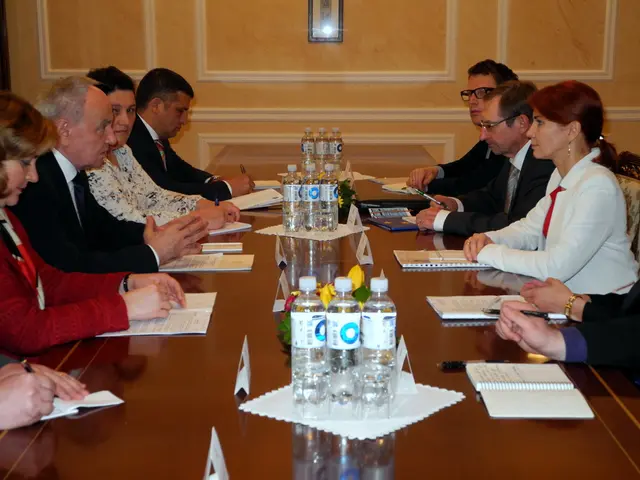Trump's doubled tariffs on steel and aluminum: Europe's uncertain response
Immediately enforced: Trump implements 50% tariffs on steel and aluminum.
Dig deep into the latest trade tensions stirred by US President Donald Trump as he implements a 50% tariff on steel and aluminum imports. Trump's bold move sets the stage for potential trade skirmishes and economic ripples.
Dials up the HeatTrade tensions have heated up, with President Trump upping the ante on import tariffs for steel and aluminum from 25% to 50%. The new tariffs, which took effect at midnight on June 5, are meant to level global trade imbalances and bolster domestic industries [1].
Britain is excluded from the increased tariffs, thanks to a trade pact with the US. However, for other countries, the increased import taxes could make goods more expensive and create difficulties in trade relationships. Economists predict consumers will feel the impact, with higher prices for cars, kitchen appliances, and canned goods among other products [2].
The US at the CrossroadsThe US is the second-largest steel importer in the world, with Canada, Brazil, Mexico, and Germany being major exporters[3]. As for aluminum, the main suppliers to the US are Canada, the United Arab Emirates, China, and South Korea [3]. The European steel industry considers the US as its most significant market, making these tariffs a significant blow.
A Trade War Brewing?Trump has been flirting with tariffs for some time, using them as a bargaining chip in his quest for more favorable trade deals. Some of these tariffs have been challenged legally, but the new duties on steel and aluminum remain unaffected [4].
Holding Breath for Europe's MoveEU officials remain tight-lipped about their response strategy, leaving the global trade community on pins and needles. Initial reactions were harsh, with EU Commission President Ursula von der Leyen warning of a trade war [5]. In preparation, the EU has been conducting a public consultation, considering countermeasures such as import duties on aircraft, automobiles, and medical devices [6]. If talks with US Trade Representative Katherine Tai fail to produce results, Europe might impose immediate countermeasures [7].
It's a game of chess, and both nations are strategizing their moves. The world watches on with bated breath, anticipating the next few moves in this diplomatic dance of trade.
- Tariffs
- USA
- Steel Industry
- EU
- Donald Trump
[1] 'Trump's new tariffs on steel and aluminum will make imports more expensive - and add turmoil to the global economy' (CNN Business, June 1, 2025)
[2] 'President Trump announces increased tariffs on steel and aluminum imports, to take effect on June 5, 2025' (US Department of Commerce, June 1, 2025)
[3] 'Top ten exporters of steel and aluminum to the US' (Investopedia, May 25, 2025)
[4] 'The EU prepares for a potential trade war: countermeasures against US tariffs under consideration' (Deutsche Welle, May 11, 2025)
[5] 'European Commission President Ursula von der Leyen: Trump's steel and aluminum tariff hike threatens global trade' (Reuters, May 8, 2025)
[6] 'EU launches consultation on potential countermeasures against US tariffs on steel, aluminum, and automotive products' (EU Commission, May 8, 2025)
[7] 'EU considers immediate countermeasures as negotiations with the US falter' (Politico, June 1, 2025)
Enrichment Data:
Overall:
The European Union (EU) is planning a strategic response to the U.S. increase in tariffs on steel and aluminum imports, which have been doubled from 25% to 50% by President Donald Trump. Here are the key points regarding the EU's response strategy:
- Retaliatory Measures Preparation: The European Commission has expressed strong regret over the tariff increase, stating that it adds uncertainty to the global economy and undermines ongoing trade negotiations [1][2]. The EU is prepared to impose countermeasures if necessary, though it has not yet implemented them [1][2].
- Public Consultation: The EU launched a public consultation on May 8, 2025, to consider potential countermeasures against U.S. tariffs on automotive, reciprocal, and aluminum products [3]. This includes reviewing additional import duties on items like aircraft, automobiles, medical devices, and IT equipment.
- Negotiation Over Retaliation: Despite the readiness to retaliate, the EU has chosen not to impose immediate countermeasures, instead focusing on ongoing negotiations with the U.S. to resolve trade issues [4]. The European Commission remains optimistic about the negotiations, hoping they will yield positive results [4].
- Recent Developments: The EU has maintained its stance of preferring negotiations over immediate retaliation, even after the U.S. tariffs took effect on June 4, 2025 [4]. European leaders continue to express optimism about the progress of these talks [4].
The EU contemplates countermeasures in response to the increased tariffs on steel and aluminum imports by the US, a move instigated by President Donald Trump. Possible countermeasures include import duties on aircraft, automobiles, and medical devices, as disclosed during the EU's public consultation [3].
The EU's employment, industry, finance, politics, and general-news sectors are closely monitoring the unfolding trade tensions between the US and the EU, recognizing the potential impact on various industries such as steel and aluminum [1].








